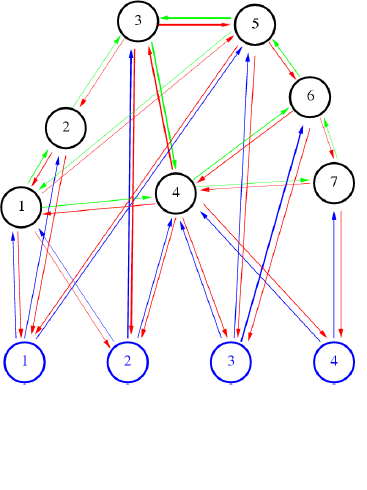Complex Adaptive Systems
Complex Adaptive Systems (CAS) consist of elements whose collective dynamics exhibit emergent properties. That is, the interactions between the elements lead to new properties of the system as a whole. Furthermore, the dynamical behaviour of CAS changes depending on external influences in a way that can be described as 'information processing'. The most prominent example of a CAS is the brain. It contains a network of many non-linear, coupled elements, i.e. neurons. The collective neuronal activity allows for adaptive processes like learning and perception which are elementary to human behaviour. Other examples of CAS include Darwinian evolution in networks of interacting species, as well as ecological and economical/social networks.
Many methods allowing for investigations on different levels ranging from single elements to effective behaviour of whole systems are shared among very different CAS. Main foci of our research are:
- Developing a theory for the emergence of diversity in evolution
- Understanding the emergence of collective behaviour and extreme events in economical systems
- Uncovering the mechanisms leading to the particular statistical properties of human closed-loop motor control.
Extreme Events in Adaptive Control
Many complex systems exhibit large-scale collective behaviours. Such large events are of high interest because they often represent crises like natural catastrophes, social upheaval, economic crashes or the failure of engineering systems. Strikingly, event magnitudes that are orders of magnitudes larger than the typically observed ones may occur much more frequently than to be expected from Gaussian distributed events. Hence, catastrophic events that should have a negligible probability based on classical statistics may dominate the dynamics of a system. Such systems often exhibit self-similar properties similar to those observed in physical systems at critical points such as magnets at the curie temperature. Such special statistical properties may provide insight in the inner structures of complex systems that may be difficult to observe otherwise. We investigate the emergence of extreme events in adaptive control systems.
Human motor control
Balancing a stick is one of the most studied control problems for engineers. When humans perform a similar task, their behaviour exhibits fluctuations that are more reminiscent of earthquakes or financial market crashes than of a system carefully designed to avoid large fluctuations. A possible explanation is continuous and rapid adaptation. Humans may plan their movements by using ad-hoc predictions to eliminate local trends they observe. Then, when e.g. a stick is in the desired upright position it is not possible to predict where the stick is going to fall until it actually falls. This mechanism induces self-similarity into control systems and can explain many properties of human control behaviour in psychophysical experiments.
Financial Markets
In economical theories it is often assumed, that traders behave maximally rational and that price fluctuations are natural consequences of efficiently balancing out arbitrage opportunities. That is, traders exploit predictable price changes thereby eliminating everything except for random fluctuations which are traditionally assumed to be Gaussian. However, price movements frequently exhibit extreme events like crashes. Further, humans often do not behave like ideal traders. We investigate the connections between market efficiency, agent behaviour, resource redistribution, and extreme events. Our studies include methods from statistical physics, multi-agent models and behavioural experiments with groups of interacting human subjects.

Evolution in Ecological Networks
Although there has been a great amount of investigations on the evolution of species and the understanding of ecosystems in the last few decades, both the origination and evolution of ecosystems as well as the observed species diversity remains still unclear. In order to study this, we investigate a population model including variable interactions which are subject to mutations. First results indicate, that very simple mutation rules are sufficient for ecological networks to emerge out of only one initial species.During many thousands of years, ecosystems have evolved through darwinian evolution. Ecosystems consist of many different species, which influence each other through several types of interactions, e.g. predator-prey interactions or mutualism. These ecosystems can be viewed as ecological networks, containing species as nodes and interactions as links between them. Taking evolution into account, the networks exhibit complex dynamics on different timescales. First, the population dynamics of the species, operating on a rather short timescale (~ days) and second, the dynamics of mutations and selection, operating usually on a much longer timescale (~ hundreds of years).
